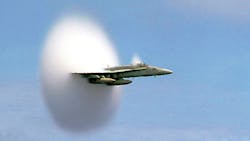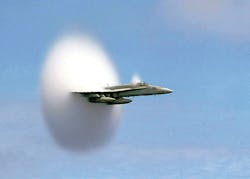The Basics of Sonic Booms
What are sonic booms?
Sonic booms are the thunderclaps of noise created when an object surpasses the speed of sound. At supersonic speeds, air behaves like a fluid—air molecules are pushed aside and form a shock wave. The larger the object, the more air it displaces and the larger the shock wave.
When do aircraft create sonic booms?
Aircraft create sonic booms when they fly at Mach numbers higher than 1.0. The Mach number is a dimensionless representation of the ratio of flow speed to a boundary and the local speed of sound:
M = u/c
where M is the Mach number, u is the local flow velocity, and c is the speed of sound (768 mph or1,236 km/h). Air is less dense in the upper atmosphere, which lets planes hit higher Mach numbers at lower speeds.
What causes sonic booms?
The shock wave created by an aircraft generates a cone of pressurized air molecules that moves outward and rearward, and extends to the ground. The overpressure profile for an aircraft, or N-wave signature, depicts the pressure rises at the nose of the aircraft, which then decreases at the tail, and then suddenly returns to normal pressure. Modern overpressures range from 1 to 10 pounds per square foot.
This file type includes high resolution graphics and schematics when applicable.
The sharp release of pressure translates into what one hears as the sonic boom. Booms occur at the initial pressure rise at the aircraft nose, and when pressure returns to normal at the aircraft’s tail. It’s usually heard as one large sonic boom rather than two.
What are the characteristics of a sonic boom?
Shock-wave strength is relative to the size and weight of the aircraft—a larger, heavier aircraft will produce stronger shock waves. The same is true regarding length and slenderness—the longer and more slender an aircraft, the weaker the shock wave. In addition, the higher the altitude of the flying object, the greater distance shock waves must travel to reach ground. The width of the boom is one mile for every 1,000 feet of altitude.


